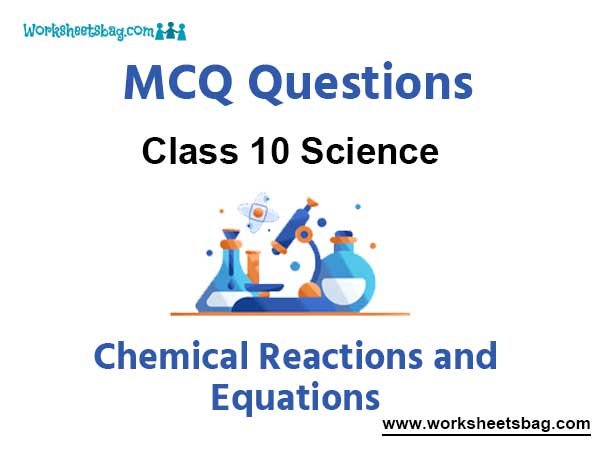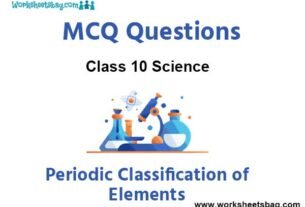Please refer to Chemical Reactions and Equations MCQ Questions Class 10 Science below. These MCQ questions for Class 10 Science with answers have been designed as per the latest NCERT, CBSE books, and syllabus issued for the current academic year. These objective questions for Chemical Reactions and Equations will help you to prepare for the exams and get more marks.
Chemical Reactions and Equations MCQ Questions Class 10 Science
Please see solved MCQ Questions for Chemical Reactions and Equations in Class 10 Science. All questions and answers have been prepared by expert faculty of standard 10 based on the latest examination guidelines.
MCQ Questions Class 10 Science Chemical Reactions and Equations
Question. A substance A reacts with another substance B to produce the product C and a gas D. If a mixture of the gas D and ammonia is passed through an aqueous solution of C, baking soda is formed. The substances A and B are
(a) HCl and NaOH
(b) HCl and Na2CO3
(c) Na and HCl
(d) Na2CO3 and H2O
Answer
B
Question: A redox reaction is one in which-
(a) both the substance are reduced
(b) both the substance are oxidised
(c) an acid is neutralised by the base
(d) one substance is oxidised while the other is reduced D
Answer:
D
Question: When the gases sulphur dioxide and hydrogen sulphide mix in the presence of water, the reaction is SO2+ 2H2S → 2H2O +3S. Here hydrogen sulphide is acting as –
(a) an oxidising agent
(b) a reducing agent
(c) a dehydrating agent
(d) a catalyst
Answer:
B
Question: The reaction in which two compounds exchange their ions to form two new compounds is –
(a) a displacement reaction
(b) a decomposition reaction
(c) an isomerization reaction
(d) a double displacement reaction
Answer:
D
Question: CuO+ H2→ H2O+ Cu, reaction is an example of –
(a) redox reaction
(b) synthesis reaction
(c) neutralisation
(d) analysis reaction
Answer:
A
Question: Black and white photography uses-
(a) decomposition of silver chloride
(b) decomposition of silver bromide
(c) both
(d) none of these
Answer:
B
Question: In the equation, NaOH+ HNO3→ HNO3→H2O +nitric acid is acting as-
(a) an oxidising agent
(b) an acid
(c) a nitrating agent
(d) a dehydrating agent
Answer:
B
Question: White silver chloride in sunlight turns to-
(a) grey
(b) yellow
(c) remain white
(d) red
Answer:
A
Question: In the following equations :
Na2CO3+ x HCl →2NaCl +CO2+ H2O, the value of x is-
(a) 1
(b) 2
(c) 3
(d) 4
Answer:
B
Question: Fe2O3+ 2Al → Al2O3+ 2Fe The above reaction is an example of a-
(a) combination reaction
(b) double displacement reaction
(c) decomposition reaction
(d) displacement reaction
Answer:
D
Question. Which of the following can be decomposed by the action of light ?
(a) NaCl
(b) KCl
(c) AgCl
(d) CuCl
Answer
C
Question. Fe2O3 + 2Al → Al2O3 + 2Fe The above reaction is an example of a –
(a) combination reaction
(b) double displacement reaction
(c) decomposition reaction
(d) displacement reaction
Answer
D
Question. White silver chloride in sunlight turns to –
(a) grey
(b) yellow
(c) remain white
(d) red
Answer
A
Question. A student added dilute HCl to a test tube containing zinc granules and made following observations which one is correct?
(a) The zinc surface became dull and black.
(b) A gas evolved which burns with a pop sound.
(c) The solution remained colourless.
(d) The solution becomes green in colour.
Answer
B
Question. Which of the following is a decomposition reaction?
(a) 2HgOHeat→2Hg +O2
(b) CaCO3Heat→CaO+ CO2
(c) 2H2OElectrolysis→H2 +O2
(d) All of these
Answer
D
Question. Which of the following is not a physical change?
(a) Boiling of water to give water vapour.
(b) Melting of ice to give water.
(c) Dissolution of salt in water.
(d) Combustion of Liquefied Petroleum Gas (LPG).
Answer
D
Question. Zn + H2SO4(dil) → ZnSO4 + H2↑ Above reaction is –
(a) decomposition reaction
(b) single displacement reaction
(c) combination reaction
(d) synthesis reaction
Answer
B
Question. The reaction in which two compounds exchange their ions to form two new compounds is –
(a) a displacement reaction
(b) a decomposition reaction
(c) an isomerization reaction
(d) a double displacement reaction
Answer
D
Question. When the gases sulphur dioxide and hydrogen sulphide mix in the presence of water, the reaction is SO2 + 2H2S → 2H2O + 2S. Here hydrogen sulphide is acting as –
(a) an oxidising agent
(b) a reducing agent
(c) a dehydrating agent
(d) a catalyst
Answer
B
Question. The equation Cu + xHNO3 → Cu(NO3)2 + yNO2 + 2H2O The values of x and y are –
(a) 3 and 5
(b) 8 and 6
(c) 4 and 2
(d) 7 and 1
Answer
C
Question. In which of the following the identity of initial substance remains unchanged?
(a) Curdling of milk
(b) Formation of crystals by process of crystallisation
(c) Fermentation of grapes
(d) Digestion of food
Answer
B
Question. Which of the following reactions involves the combination of two elements?
(a) CaO + CO2 → CaCO3
(b) 4Na + O2 → 2Na2O
(c) SO2 + 1/2 O2 →SO3
(d) NH3 + HCl → NH4Cl
Answer
B
Question. On the basis of following features, identify the correct option.
(i) This reaction occurs during corrosion.
(ii) This reaction occurs during respiration.
(a) Decomposition reaction
(b) Redox reaction
(c) Combination reaction
(d) Endothermic reaction
Answer
B
Question. CuO + H2 → H2O + Cu, reaction is an example of –
(a) redox reaction
(b) synthesis reaction
(c) neutralisation
(d) analysis reaction
Answer
A
Question. Zn2+(aq) + 2e– → Zn(s). This is –
(a) oxidation
(b) reduction
(c) redox reaction
(d) none of these
Answer
B
Question. Black and white photography uses –
(a) decomposition of silver chloride.
(b) decomposition of silver bromide.
(c) both
(d) none of these
Answer
B
Question. When copper powder is heated it gets coated with –
(a) black copper oxide
(b) yellow copper oxide
(c) red copper oxide
(d) None of these
Answer
A
Question. When hydrogen sulphide gas is passed through a blue solution of copper sulphate, a black precipitate of coppersulphide is obtained and the sulphuric acid so formed remains in the solution. The reaction is an example of
(a) a combination reaction
(b) a displacement reaction
(c) a decomposition reaction
(d) a double decomposition reaction
Answer
D
Question. Chemically the ‘water gas’ is
(a) H2O (gaseous)
(b) CO2 + H2
(c) CH4 + H2O
(d) CO + H2
Answer
D
Question. What is the colour of CuSO4.5H2O?
(a) Blue
(b) Green
(c) White
(d) Yellow
Answer
A
Question. Four students used different ways of burning magnesium ribbon during an experiment as shown below.
The correct way has been followed by student: (Diagram)
(a) I
(b) II
(c) III
(d) IV
Answer
C
Question. The copper coin is dipped in blue coloured copper sulphate solution, the colour obtained after half an hour is
(a) Reddish
(b) Brownish
(c) Colourless
(d) blue colour
Answer
D
Question. When iron nail js kept in blue coloured copper sulphate solution, after a while the colour obtained in the test tube for the solution is
(a) Blue
(b) Brown
(c) Green
(d) Red
Answer
C
Question. On adding zinc granules to freshly prepared ferrous sulphate solution a student observes that:
(a) a dull brown coating is formed
(b) a black coating is formed
(c) a greyish coating is formed
(d) no coating is formed.
Answer
C
Question. A student strongly heats hydrated ferrous sulphate salt in a dry test tube. He would observe a:
(a) yellow residue
(b) brown residue
(c) light green residue
(d) white residue
Answer
B
Question. A student while heating solid lead nitrate taken in a test tube would observe
(a) white residue of PbO2
(b) green residue of NO2
(c) yellow residue of PbO
(d) brown residue of NO
Answer
C
Question. A student took solid quick lime in a china dish and added a small amount of water. He heard
(a) a popping sound
(b) a crackling sound
(c) a hissing sound
(d) no sound at all
Answer
B
Question. The colour of the gas evolved on heating solid lead nitrate is
(a) Yellow
(b) Brown
(c) greenish-yellow
(d) green
Answer
B
Question. Which of the following is termed as oxidizing agent?
(a) Which gives oxygen
(b) Which removes oxygen
(c) Which gives hydrogen
(d) All of the above
Answer
A
Question. Which of the following termed as reducing agent?
(a) Which gives oxygen
(b) Which removes oxygen
(c) Which removes hydrogen
(d) All of the above
Answer
B
Question. Three beakers labelled as A, B and C each containing 25 mL of water were taken. A small amount of NaOH, anhydrous CuSO4 and NaCl were added to the beakers A, B and C respectively. It was observed that there was an increase in the temperature of the solutions contained in beakers A and B, whereas in case of beaker C, the temperature of the solution falls. Which one of the following statements(s) is (are) correct?
(i) In beakers A and B, exothermic process has occurred.
(ii) In beakers A and B, endothermic process has occurred.
(iii) In beaker C exothermic process has occurred.
(iv) In beaker C endothermic process has occurred.
(a) (i) only
(b) (ii) only
(c) (i) and (iv)
(d) (ii) and (iii)
Answer
C
Question. Corrosion of metals can be prevented
(a) by coating the metal surface with a paint.
(b) by applying film of grease and oil on the surface of the metal.
(c) by covering the surface of the metal with another metal which is more electropositive.
(d) all of these.
Answer
D
Question. Identify the chemical equation which represents a complete balanced equation for the reaction
of barium chloride with sodium sulphate to produce barium sulphate and sodium chloride.
(a) BaCl2(aq) + Na2SO4(aq) BaSO4(s) + NaCl(aq)
(b) BaCl2(aq) + Na2SO4(aq) 2BaSO4(s) + 2NaCl(aq)
(c) 2BaCl2(aq) + Na2SO4(aq) 2BaSO4(s) + NaCl(aq)
(d) BaCl2(aq) + Na2SO4(aq) BaSO4(s) + 2NaCl(aq)
Answer
D
Question. Which of the following is not a physical change?
(a) Boiling of water to give water vapour
(b) Melting of ice to give water
(c) Dissolution of salt in water
(d) Combustion of Liquefied Petroleum Gas (LPG)
Answer
D
Question. Which among the following is (are) double displacement reaction(s)?
(i) Pb + CuCl2 PbCl2 +Cu
(ii) Na2SO4 + BaCl2 BaSO4 + 2NaCl
(iii) C + O2 CO2
(iv) CH4 + 2O2 CO2 + 2H2O
(a) (i) and (iv)
(b) (ii) only
(c) (i) and (ii)
(d) (iii) and (iv)
Answer
B
Question. Which of the following reactions represents a combination reaction?
(a) CaO(s) + H2O(l) Ca(OH)2 (aq)
(b) CaCO3(s) CaO(s) + CO2(g)
(c) Zn(s) + CuSO4(aq) ZnSO4(aq) + Cu(s)
(d) 2FeSO4(s) Fe2O3(s) + SO2(g) + SO3(g)
Answer
A
Question. Which of the following observation help(s) us to determine that a chemical change has taken place?
(a) Change in temperature.
(b) Change in colour.
(c) Evolution of a gas.
(d) All of these.
Answer
D
Question. A dilute ferrous sulphate solution was gradually added to the beaker containing acidified potassium permanganate solution. The light purple colour of the solution fades and finally disappears. Which of the following is the correct explanation for the observation?
(a) KMnO4 is an oxidising agent, it oxidises FeSO4
(b) FeSO4 acts as an oxidising agent and oxidises KMnO4
(c) The colour disappears due to dilution; no reaction is involved
(d) KMnO4 is an unstable compound and decomposes in presence of FeSO4 to a colourless compound.
Answer
A
Question. Which of the following is (are) an endothermic processes?
(i) Dilution of sulphuric acid. (ii) Sublimation of dry ice.
(iii) Condensation of water vapours. (iv) Evaporation of water.
(a) (i) and (iii)
(b) (ii) only
(c) (iii) only
(d) (ii) and (iv)
Answer
D
Question. Which of the following are exothermic processes?
(i) Reaction of water with quick lime
(ii) Dilution of an acid
(iii) Evaporation of water
(iv) Sublimation of camphor (crystals)
(a) (i) and (ii)
(b) (ii) and (iii)
(c) (i) and (iv)
(d) (iii) and (iv)
Answer
A
Question. In which of the following heat is evolved?
(a) Combination reaction
(b) Decomposition reaction
(c) Displacement reaction
(d) Double displacement reaction
Answer
A
Question. In which of the following heat is absorbed generally?
(a) Combination reaction
(b) Decomposition reaction
(c) Displacement reaction
(d) Double displacement reaction
Answer
B
Question. Which one of the following processes involve chemical reactions?
(a) Storing of oxygen gas under pressure in a gas cylinder
(b) Liquefaction of air
(c) Keeping petrol in a china dish in the open
(d) Heating copper wire in presence of air at high temperature
Answer
D
Question. In the double displacement reaction between aqueous potassium iodide and aqueous lead nitrate, a yellow precipitate of lead iodide is formed. While performing the activity if lead nitrate is not available, which of the following can be used in place of lead nitrate?
(a) Lead sulphate (insoluble)
(b) Lead acetate
(c) Ammonium nitrate
(d) Potassium sulphate
Answer
D
Question. Solid calcium oxide reacts vigorously with water to form calcium hydroxide accompanied by liberation of heat. This process is called slaking of lime. Calcium hydroxide dissolves in water to form its solution called lime water. Which among the following is (are) true about slaking of lime and the solution formed?
(i) It is an endothermic reaction
(ii) It is an exothermic reaction
(iii) The pH of the resulting solution will be more than seven
(iv) The pH of the resulting solution will be less than seven
(a) (i) and(ii)
(b) (ii) and (iii)
(c) (i) and (iv)
(d) (iii) and (iv)
Answer
B
Question. What happens when dilute hydrochloric acid is added to iron filings?
(a) Hydrogen gas and iron (II) chloride are produced.
(b) Chlorine gas and ferric hydroxide are produced.
(c) Heat is absorbed, i.e., test tubes becomes cold.
(d) Iron salt and water are produced.
Answer
A
Question. The following reaction is used for preparation of oxygen gas in the laboratory:
2KClO3 (s) Heat /Catalyst 2KCl(s) + 3O2 (g)
Which of the following statements is correct about the reaction?
(a) It is a decomposition reaction and endothermic in nature.
(b) It is a combination reaction.
(c) It is a decomposition reaction and is accompanied by release of heat.
(d) It is a photo chemical decomposition reaction and exothermic in nature.
Answer
A
Question. The following reaction is an example of a
4NH3 (g) + 5O2 (g) 4NO(g)+ 6H2O(g)
(i) displacement reaction
(ii) combination reaction
(iii) redox reaction
(iv) neutralisation reaction
(a) (i) and (iv)
(b) (ii) and (iii)
(c) (i) and (iii)
(d) (iii) and (iv)
Answer
C
Question. In which of the following equations, the mass is not same on both the sides?
(a) Word equation
(b) Skeletal equation
(c) Balanced equation
(d) Both (a) and (b)
Answer
D
Question. What happens when copper rod is dipped in iron sulphate solution?
(a) Copper displaces iron
(b) Blue colour of copper sulphate solution is obtained
(c) No reaction takes place
(d) Reaction is exothermic
Answer
C
Assertion-Reason Questions
In the following question, a statement of Assertion
(A) is followed by a statement of Reason (R). Answer these questions by selecting appropriate option given below:
(a) Both Assertion (A) and Reason (R) are true and Reason (R) is the correct explanation of Assertion (A).
(b) Both Assertion (A) and Reason (R) are true but Reason (R) is not the correct explanation of Assertion (A)
(c) Assertion (A) is true but Reason (R) is false.
(d) Assertion (A) is false but Reason (R) is true.
Question. Assertion (A): Quicklime reacts vigorously with water releasing a large amount of heat.
Reason (R): The above chemical reaction is an exothermic reaction.
Answer
A
Question. Assertion (A): Photosynthesis is considered as an endothermic reaction.
Reason (R): Energy gets released in the process of photosynthesis
Answer
C
Question. Assertion (A): A reducing agent is a substance which can either accept electron.
Reason (R): A substance which helps in oxidation is known as reducing agent.
Answer
D
Question. Assertion (A): Pungent smelling gas is produced when sulphur burns in air.
Reason (R): Sulphur trioxide is formed on reaction of sulphur with oxygen.
Answer
C
Question. Assertion (A): Carbon dioxide turns lime water milky.
Reason (R): Carbon dioxide sullies the water.
Answer
C
(a) If both Assertion and Reason are correct and Reason is the correct explanation of Assertion.
(b) If both Assertion and Reason are correct, but Reason is not the correct explanation of Assertion.
(c) If Assertion is correct but Reason is incorrect.
(d) If Assertion is incorrect but Reason is correct.
Question. Assertion: When a mixture of hydrogen and chlorine is placed in sunlight, hydrogen chloride is formed.
Reason : It is an example of combination reaction.
Answer
A
Question. Assertion : When copper strip is placed in ferrous sulphate solution, colour of the solution changes.
Reason : Iron is more reactive than copper.
Answer
D
Question. Assertion : Stannous chloride gives grey precipitate with mercuric chloride, but stannic chloride does not do so.
Reason : Stannous chloride is a powerful oxidising agent which oxidises mercuric chloride to mercury.
Answer
C
Question. Assertion : Corrosion of iron is commonly known as rusting.
Reason : Corrosion of iron occurs in presence of water and air.
Answer
B
Fill in the Blanks :
Question. Reactions in which heat is given out along with the products are called ………………….. reactions.
Answer
exothermic
Question. When calcium carbonate is heated, it decomposes to give ……………… and …………….. .
Answer
CaO (s) and CO2 (g)
Question. Precipitation reactions produce ……………….. salts.
Answer
insoluble
Question. Reduction is the …………….. of oxygen or gain of hydrogen.
Answer
loss
True or False :
Question. Oxidation is the loss of electrons from a substance.
Answer
True
Question. Action of heat on ferrous sulphate is an example of decomposition reaction.
Answer
True
Question. Reduction is the gain of electrons by a substance.
Answer
True
Question. A complete chemical equation represents the reactants, products and their physical states symbolically.
Answer
True



